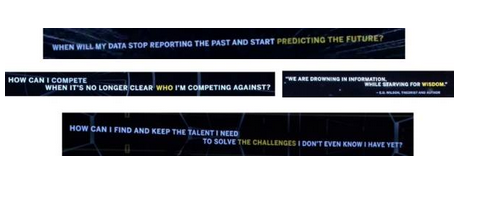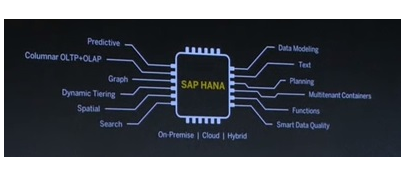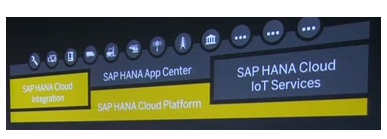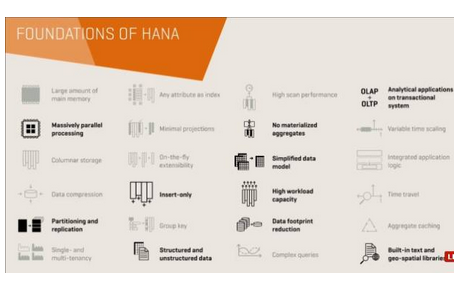10 Insider Takeaways From Sapphire 2015

TAKE NOTE(Insights into SAP solutions and EmergingTechnology)
1. New SaaS – Simple as a service – Run Simple continues as SAP’s mantra

Let’s start with main theme of what our CEO breathes internally and externally, it’s about making the world run simple, and into this year this mantra continues to be the focus.

The vision of helping improve people life ….by offering “Simple” as a service, the new SaaS model.
2. Consumers to Business Market – facebook & google partnerships
We no more are in Business to Business to Consumer market or Business to Business market, but we live in a world of consumer to business market, where consumer is the king and center to the transformation to run data driven and seamless business.
To get there, SAP announced couple of significant partnership with facebook and google – enable getting facebook to partner in their pursuit connecting consumers with business and connecting google docs with SAP.
3. Run Data Driven Business – HANA /HANA Cloud Platform
When asked to many CEOs, the one answer you get is “Do sophisticated things easy”. The sophistication part is the “data” part in the back end.
What is the risk of doing things? Better question to ask is what’s the risk of not doing things – leading you to be an also ran company. “Delay or Go”….choose the path you would like to take…to go data driven.
Both Under Armour & Enel Group were great examples of how data drives business forward.
HANA is center of achieving this data driven business transformation to answer the following questions :

and here is a simple glimpse of what this HANA platform covers

& more specific on the HANA cloud platform, being the PaaS of choice for this data driven businesses

The interesting part that was shared was the HANA roadmap which is likely to now work with Hadoop & Spark…certainly taking the momentum further as one of the real big data platform.

Prof Hasso Plattner shared that no more we need applications for the just the past, but the system for forecast. This is the trend he saw with in memory database. He mentioned that he didn’t want to be a trusted advisor for businesses but a trusted innovator for businesses, and its through foundation of HANA

4. Run Seamless Business – Customer Engagement & Commerce | Engaged Employees
The second part of the ‘do sophisticated things easy’ is “things easy” part, which is where businesses have to focus on running it ‘seamless’
Bill shared how today’s business are no more talking about their customers channels in a siloed approach but focus on seamless interaction across multiple channels, and provide seamless experience to customers. Knowing more about the customers is part of this and SAP’s next generation Customer Engagement & Commerce helps there extensively.
Bill shared another story of how “not doing anything is exhausting” …and how important it is to have an engaged employee. This is key part of the SAP’s Successfactors and HCM solutions, that helps run seamless.
If you have the time, watch the replay of the keynote here
5. Go Digital – SAP Digital

While SAP likes to preach, it would like to practice that too. Clear example is when it announced creating of new business called SAP Digital led by its former CMO Jonathan Becher, where SAP wanted to serve his customers, partners and ecosystem through digital channels. And at SAPPHIRENOW, there was much progress shown with SAPStore.com . SAP Digital opens new doors for consuming SAP products and services, including education and content
6. Bread & Butter – S4HANA – Board Rooms of the future
SAP is into its 4th generation of Business Application systems – the bread & butter for businesses that run SAP. With HANA Cloud Platform, the possibilities are new – moving away from being a system of record to system of simulations, moving to the board rooms.
 Berndt in his keynote explained whats covered in S4HANA, how SAP is moving from selling products to selling output, and shared stage with CIO of Asian Paints who explained how the S4HANA journey is helping rethinking how IT can help in business model transformation. Some amazing demo example were shown of how the simulation can work with the completely redesigned role based fiori Ux to support this simplified backend. Example was how you could quickly review the customer performance through simulation and move orders.
Berndt in his keynote explained whats covered in S4HANA, how SAP is moving from selling products to selling output, and shared stage with CIO of Asian Paints who explained how the S4HANA journey is helping rethinking how IT can help in business model transformation. Some amazing demo example were shown of how the simulation can work with the completely redesigned role based fiori Ux to support this simplified backend. Example was how you could quickly review the customer performance through simulation and move orders.

Berndt also acknowledged the fact that most businesses are not in the same stage of the business transformation and laid out a nice roadmap for customers, for this data driven and seamless business with S4HANA.
Step 1: Move to HANA | Step 2: Transform to S4HANA | Step 3: Choose your deployment
Another great piece that was presented is how HANA Cloud Platform can be integrated to S4HANA and there can be apps built around it. There are already 1000+ apps built on this platform and SAP will expose APIs from S4HANA, the same APIs that Fiori UIs consume, for others to leverage as they build apps. This can be a great one for partners and others to leverage.

Board Rooms of the future

Prof Hasso Platner shares how the board rooms will look like, with an example of how it looks for SAP.
No more KPIs but real time active tiles, drill if its interesting right in the fingers of bosses, without relying on massing IT dependency. And the focus is on future, on simulations, and not on the past. Truly real time performance management solutions

Best quote from Prof Hasso :
“we need to make points with power and don’t need power points in board meeting”
7. Yes this is the Perfect Trip
Now getting on to the new baby at SAP.
Perfect Trip is the perfect example for “Simple” as a service.
“Keep the complexity in the backend across the travel network, and keep the front end simple”
With Concur, there was an amazing showcase of how a perfect trip can be enabled, what a pain killer for time we spend from travel booking across airlines, hotels & rental to submit back the experience. It totally eliminates the pain, and the business traveler focus on real purpose of his travel. The walkthrough in 3 minutes was amazing how you could buy your tickets with mobile, book your hotels from your SPG membership site and get your expenses booked seamlessly, as well as having the itinerary automated with TripIt.

8. How we connect – Today & Tomorrow – Business Network
This one is huge and getting into the disruptive innovation area for SAP. Business Network is a really big bet. SAP has this great networks – for procurement of goods & services with Ariba, for channeling contract labor with fieldglass and for perfect trip with concur. Already these are best of breed networks for addressing each of those specific areas. While each one of these are unique, there are some common areas that can be leveraged across these networks such as identy resolution, security, payments, analytics etc.

Steve Singh laid out the vision for how this networks are going to get connected, and how all of this can be connected with SAP HANA Cloud Platform in the future. He showed a cool use case that started off with aircraft sensor identifies that a spare part needs to be replaced, which can trigger a procurement transaction in Ariba, and lead to getting contingent experts through Fieldglass and eventually covering their travel requirements through concur. While this was one, there could be 1000s of such use cases that can be addressed across the network of networks, and this can be achieved in the near future. This also becomes the “simple” as service…to drive Trillion $ business in the network…on cloud

9. New Horizons – Internet of Things
Key emerging business technology trend is Internet of Things. For SAP, the key focus here is on enabling businesses that run SAP and beyond to get ready for the Internet of Things era. Berndt announced that IoT to be successful, it needs to be connected to cloud, and announced SAP will have IoT services in HANA Cloud Platform.
An important announcement here was the partnership with Siemens who will leverage SAP HANA Cloud Platform, and it was really great to see the potential here.

A great customer use case was presented on how Houston Utilities company already leverages SAP Predictive Maintenance solutions to manage maintenance by exception, find root cause analysis as well as take action. Also enabled through the latest gadgets such as smartwatch.


Watch Berndt & Steve keynote if you have the time.
To wrap it up, there was an interesting discussion by panel on IoT which is worth watching if you have the time.
10. Customer Innovation – real customers, real problems, real data
The proof of the pudding is when you eat it…all the above data driven, seamless, simple talk is not vision but they are actual examples that customers are using SAP HANA and beyond

The most entertaining part of the whole thing was when Walmart, yes Walmart, CIO arenann Terrell was on stage with Berndt and Rob Enslin discussing how Walmart runs fast, real time stuff with SAP HANA alongwith their backoffice leveraging SAP ERP. Walmart serves 5.5 million consumers every day, served by 220k associates, needs to handle half billion transactions with 5000 concurrent users in subseconds time.
She explained how speed is no more a choice but a must have, and how technology can enable data driven businesses. “Technology innovation is fine, but real value is application of technology into business”. Talent that intersects between technology and business are the key folks.
Most stunning quote from her was “Hope she can complete SAP implementation in her lifetime” basically citing the complexity of the business they run, and how transformation is such an enormous initiative.
She nicely laid out the three key aspects of running today’s business leveraging technology
1. Help optimize the cost
2. Real time
3. Help serve customers better

Another interesting customer that won the HANA innovation award was ConAgra that embarked on a journey of total margin management, being able to analyse and simulate cost of goods, giving the visibility to the business users to take great action, and therefore enable profit optimization. You can check out the innovation in more detail.
Prof Hasso Plattner says we would have not created some amazing systems with HANA, if we had not co-innovated with real customers, real problems, and real data.
A very amazing demo by Colgate on how they are now running their board rooms with SAP HANA, a critical way to innovate on this new real time simulation and board room system.

Another great example of real time stock, and trade promotions with a large foods company got shown

Prof Hasso Plattner also shared how design thinking is helping significantly. It’s the process of spending lot of time upfront with customers /users to understand what do they want and also stimulate a discussion that would lead to some great innovations. He pointed out a classic example of this is iphones. But really thinks that customer co- nnovation is the best way to build software in the current era.
And some amazing customer innovations in the health care area, digitized health data, clinical data. How the data can be used by the entire ecosystem – across doctors, the life science companies, research etc. Health care cancer consortium choose technology partner who can complement – SAP HANA was the right platform for ‘Cancer Link’.
Don’t miss this amazing keynote by visionary Prof Hasso Plattner – business systems powered by in-memory
In summary, these are key takeaways in the world of business technology that SAP is enabling and presented here at SAPPHIRENOW for today and future….

This story originally appeared on SCN HERE
UNDER DEVELOPMENT(Information for ABAP Developers)
ABAP Dynamic Programming Techniques
OK, lets pick up from last month where I promised we would look at how to use the Runtime Type Identification (RTTI) technique to get information at runtime about data that is passed with generic types. So lets get started…
Runtime Type Identification (RTTI)
Runtime Type Identification (RTTI) is a powerful technique for obtaining all information about a data type at runtime. When you use dynamic programming techniques, sometimes you need to dynamically determine the data type or properties in order to decide how to handle the data. This situation typically occurs when you use generic types, where you need to obtain at runtime the missing data characteristics not described by the generic type. For example, if you use the generic type ANY in a subroutine, you will need to get information at runtime about the type of the data being passed.
RTTI is implemented in ABAP Objects using description objects. Description objects for types are created from description classes, and every type in the ABAP hierarchy has a corresponding description object. Next, every description class has special attributes and appropriate navigation methods. For instance, the class CL_ABAP_TABLEDESCR has an attribute TABLE_KIND and a navigation method GET_TABLE_LINE_TYPE.
In the RTTI class hierarchy. As you can see below, the class CL_ABAP_TYPEDESCR is the root class, which contains all methods to derive a description object from a data type or the name of the type.

Q&A(Your Questions answered)
Q. I am a SRM Consultant in commerical areas. I am moving to federal type program that uses a product called PPS. Is this SRM or different?
A. SAP PPS is a relatively new solution that focuses on the procurement processes of government organizations and other public sector entities. It is primarily an SAP SRM–based solution that fully integrates with the funds management (FM) and materials management functionalities in SAP ERP.
The SAP PPS solution combines the SAP SRM, SAP ERP, SAP Records Management, Document Builder, and SAP NetWeaver applications to collaborate and support public sector customers. Public sector organizations can use the capabilities of the solution to maintain Federal Acquisition Regulations (FAR) clauses and detailed FAR document and contracts, and integrate these with the enhanced sourcing and procurement capabilities within SAP SRM.
Here is a high level the various applications that make up the overall PPS solution.

So the overall answer to your question is SAP SRM provides the underlying foundation for SAP PPS. In many cases, SAP PPS extends or augments the standard functionality provided in SAP SRM.

